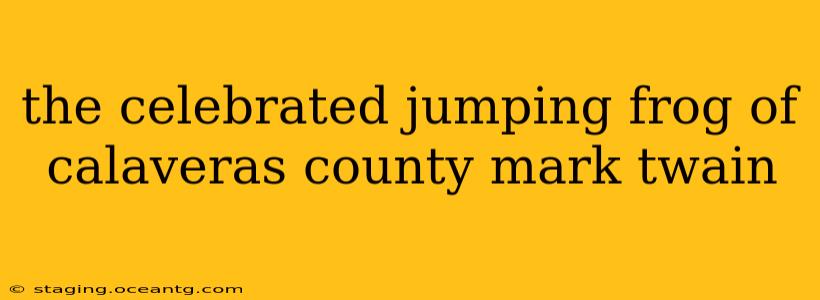Mark Twain's "The Celebrated Jumping Frog of Calaveras County" is more than just a humorous short story; it's a cornerstone of American literature, showcasing Twain's masterful use of vernacular, satire, and storytelling. Published in 1865, this seemingly simple tale continues to captivate readers with its wit and unexpected depth, solidifying its place as a classic. This exploration delves into the story's enduring appeal, examining its narrative structure, themes, and lasting impact on literature.
What is the main point of "The Celebrated Jumping Frog of Calaveras County"?
The main point isn't easily summarized in a single sentence, as Twain's brilliance lies in his layered approach. On the surface, it's a humorous anecdote about a prodigious jumping frog. However, beneath the surface lies a satirical commentary on human gullibility, the power of storytelling, and the clash between sophisticated Eastern sensibilities and the rough-hewn culture of the American West. The narrator's initial skepticism and eventual acceptance of the outlandish tale highlight the ambiguity of truth and the persuasive nature of a skilled storyteller. Ultimately, the story's point is to entertain while subtly questioning our perception of reality and the stories we choose to believe.
What is the significance of the setting in "The Celebrated Jumping Frog of Calaveras County"?
The setting of Calaveras County, California, is crucial. It establishes the story's frontier context, a place characterized by its boisterous, unpredictable, and often naive inhabitants. This setting perfectly complements the tall tale's outlandish premise. The rough-and-tumble atmosphere of the mining town allows for the acceptance of an unbelievable story, contrasting sharply with the narrator's refined, Eastern expectations. This contrast underscores the cultural differences and the potential for misunderstanding between these disparate worlds.
What type of story is "The Celebrated Jumping Frog of Calaveras County"?
"The Celebrated Jumping Frog of Calaveras County" is best classified as a frame story within the genre of a tall tale. The narrative structure employs a frame story, where the main story (Simon Wheeler's tale about the frog) is embedded within a larger narrative (the narrator's quest for information about Leonidas Smiley). It's also undeniably a tall tale—a humorous story with exaggerated elements and unbelievable characters. The story's success lies in its convincing delivery of the outlandish narrative, despite its inherent absurdity.
What are the major themes in "The Celebrated Jumping Frog of Calaveras County"?
Several key themes intertwine throughout the story:
- Regionalism and Local Color: The story vividly captures the distinct character of the American West, with its unique dialect, customs, and storytelling traditions.
- Truth and Deception: The story plays with the notion of truth versus fiction, blurring the lines between reality and exaggeration. Is Simon Wheeler a reliable narrator? Is the story of the frog true, or is it a carefully crafted deception?
- Human Nature and Gullibility: Twain satirizes human nature by highlighting our susceptibility to believing outlandish tales, especially when presented with convincing storytelling.
- Storytelling as an Art Form: The story itself is a testament to the power and artistry of storytelling. Simon Wheeler's mastery of narrative captivates the listener, even though the story itself is incredibly improbable.
What is the significance of the character Simon Wheeler?
Simon Wheeler is the crucial character responsible for delivering the main story. He is a masterful storyteller, even if his stories are unbelievable. His rambling, digressive style of narration adds to the humorous effect and reflects the casual, unhurried nature of the frontier setting. He's a caricature of a certain type of Western storyteller, full of local color and charm but also potentially unreliable. The contrast between Wheeler’s rambling style and the narrator’s more refined style helps emphasize the clash of cultures and expectations.
What literary devices does Mark Twain use in "The Celebrated Jumping Frog of Calaveras County"?
Mark Twain masterfully employs various literary devices to create the story's distinctive tone and humor:
- Dialect: The use of vernacular language, specifically the dialect of the American West, contributes significantly to the story's authenticity and comedic effect.
- Irony: The irony lies in the narrator's expectation of finding a serious and informative account, only to receive a tall tale, further enhancing the humor.
- Hyperbole: The exaggerated size and jumping abilities of the frog exemplify the use of hyperbole, a crucial element of the tall tale genre.
- Frame Narrative: The embedding of Simon Wheeler's story within the narrator's experiences creates a layered narrative structure that adds depth to the story.
Conclusion: The Enduring Legacy of a Jumping Frog
"The Celebrated Jumping Frog of Calaveras County" remains a significant work in American literature, not simply for its humor but for its subtle exploration of cultural differences, the power of storytelling, and the complexities of human nature. Its lasting appeal lies in Twain's masterful use of language, narrative structure, and his ability to weave a seemingly simple tale into a nuanced commentary on the human condition. The story's enduring popularity is a testament to Twain's genius and the timeless appeal of a well-told, even if slightly unbelievable, story.
